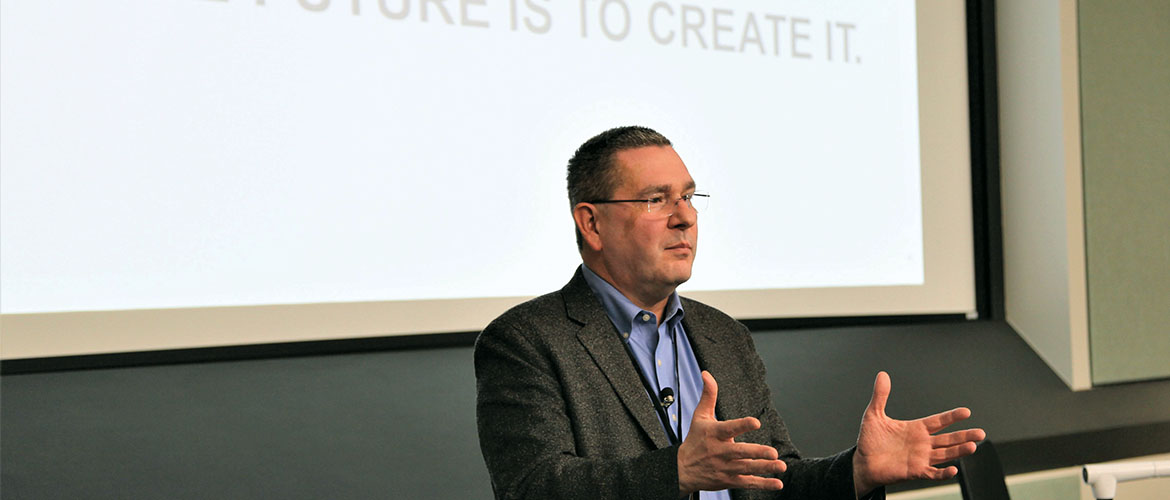
Global Impact
Thursday, August 29, 2019
Kimberly-Clark’s first chief scientist offers his take on the future at OSU conference
Oklahoma State University alumnus Peter Dulcamara is the chief scientist and technical vice president of consumer goods giant Kimberly-Clark. The company, which is known for some of country’s most recognizable brands — Huggies, Kleenex, Kotex and more — aims to lead the world in essentials for a better life. And that suits Dulcamara perfectly.
“I feel fortunate to work for a company where the business mission aligns with my personal mission to create a better, more sustainable future,” Dulcamara said on a recent visit to OSU.
"I never think of myself as an employee of Kimberly-Clark. Rather, I see my role at the company as part of a larger purpose, aligned to my personal mission which is to help create businesses that improve people’s lives,” he said. “Stress is what you feel when you are working on something you don’t like, and passion is working on something you love. I feel blessed to be working on my life’s passion at Kimberly-Clark.”
Dulcamara sees his role as the company’s chief scientist as both innovator and coach.
The OSU grad is the first chief scientist in the history of Kimberly-Clark. His role is to ensure that the company has an enterprise-wide research and engineering technology strategy, continues to grow its technical talent and strengthens its culture of innovation and value creation.
He received his bachelor’s degree in chemistry from Cameron University in Lawton, Oklahoma. Unsure of his next step, he reached out to OSU’s engineering department to pursue a master’s degree in chemical engineering.
However, Dr. Rob Robinson, the chemical engineering adviser and faculty member, didn’t think it would be a good idea for Dulcamara to go directly into the master’s program lacking a bachelor’s in engineering to ground him.
“Rob told me that he wanted me to start in the bachelor’s degree program for chemical engineering to see how the first semester would go,” Dulcamara said. “The first semester went really well, and I was setting some of the grading curves. Rob ended up hiring me to work in his interfacial tension lab and became my adviser for my master’s thesis.”
Dulcamara ended up getting both his bachelor’s degree (1986) and master’s degree (1987) in chemical engineering at OSU.
“What I really loved about OSU was the balance between science, technology and pragmatism,” he said. “There is a strong work ethic instilled here at OSU. Everyone I knew in my class has done well in industry because of the education they received here. The culture fostered in the School of Chemical Engineering enabled me to leave the program with the belief that I could solve problems, communicate with confidence and influence others at every level in an organization.”
Dulcamara spent 18 years at Dow Chemical Co., working in plastics, chemicals and new business development. He joined Kimberly-Clark in 2006 as vice president of global science and technology before being named vice president of corporate research and engineering in 2009. He became the company’s chief scientist in May 2018.
Dulcamara recently returned to OSU as the keynote speaker for the International Conference on Web Handling. There, he spoke on data science, machine learning, artificial intelligence and transformational innovation. He demonstrated how they relate to research his company is doing as well as industry in Oklahoma.
Today, electricity is in the background making everything work. In the near future, artificial intelligence will be in the background making everything work a whole lot better,” he said.
“It is really important to understand artificial intelligence, network effects and other exponential technologies and how we apply these capabilities to everything we do,” Dulcamara added. “At Kimberly-Clark, we use artificial intelligence to make better predictions that lead to better business decisions, and ultimately, lead to making lives better for our consumers.
“Almost every industry of the 20th century was based on oil, electricity and steel. Today, data is the new oil. Artificial intelligence is the new electricity. And robotics is the new steel. This is the infrastructure for innovation in the 21st century.”
